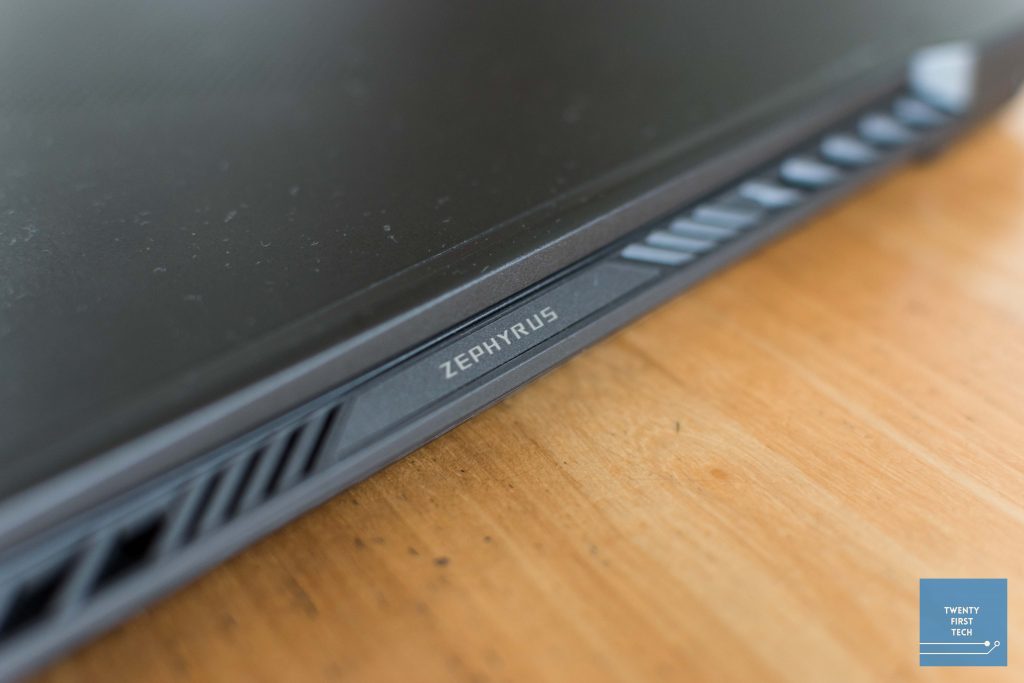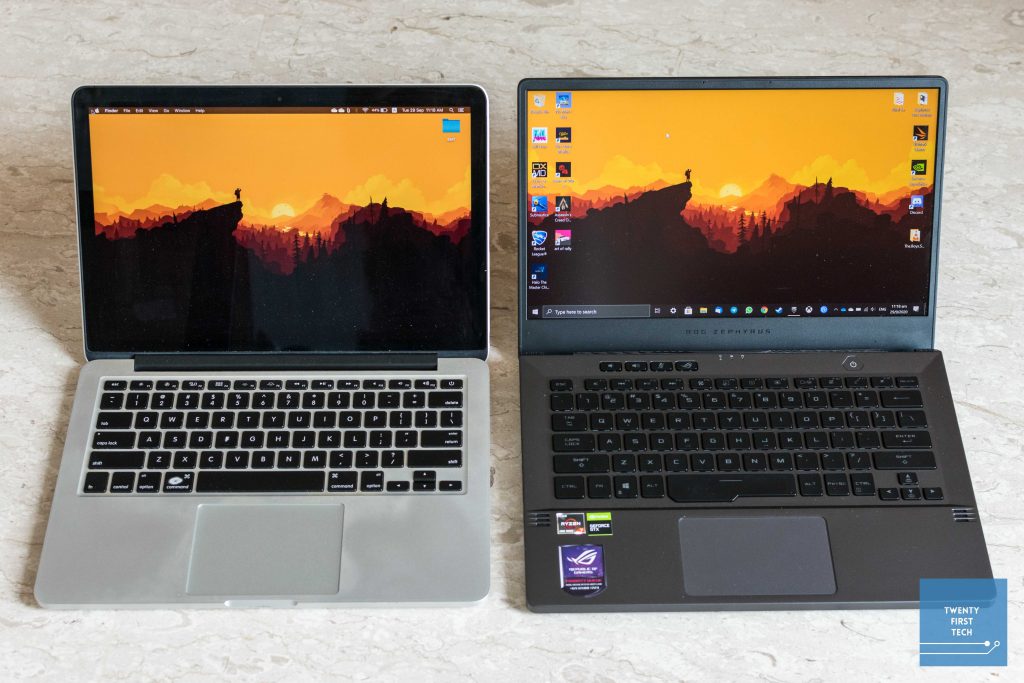The ASUS ROG Zephyrus G14 is a stellar device, if you can get your hands on it, and preferably outside of Singapore. More on that in our Zephyrus G14 review.
In March of this year, the press was abuzz about AMD’s Ryzen 4000 series of chips. These chips were said to provide a level of power, efficiency, and longevity never before seen in gaming laptops. And leading the wave of Ryzen-equipped laptops was the ASUS ROG Zephyrus G14.
Early reviews for the G14 were stellar. The Verge wrote that “AMD has rewritten the rules of what a gaming laptop can be”. Linus Tech Tips called the Ryzen 9 4900HS powering the G14 “AMD’s most important product ever”.
That was 6 months ago, so why am I only reviewing the product now? There are several reasons. First is the delay in the G14’s Singapore launch date till June. Second would be the supply issues that this laptop is facing — as of the time of this writing, the G14 is still out of stock on the ASUS Singapore online store. An ASUS spokesperson has told me that whenever the device is restocked it sells out within a day or two.
There are a ton of reviews out there already, but mostly in a North American context. Here’s a summary of the reviews so far: The ASUS ROG Zephyrus G14 is a stellar gaming laptop with great performance in a package with previously-unheard-of battery life and portability, at a great price.
Instead of parroting what other reviewers have already said, I’ll try to add some value in the form of Singaporean context. And in the Singaporean context, as I alluded to earlier, availability is a major sore spot. But equally so is the local pricing.
I will focus on what I feel is the most important conversation of pricing and availability later, but first let me quickly run through my review of the device.
As always, let’s start with the specs.
Zephyrus G14 Specs (as tested)
- 2.9GHz AMD Ryzen 7 4800HS (8-core), turbo to 4.2GHz
- NVIDIA GTX 1650 Ti 4GB (RTX 2060 Max-Q variant available*)
- 16GB DDR4 RAM
- 1TB M.2 NVMe PCIe 3.0 SSD
- 14.0″ FHD 1920×1080 120Hz display
- 32.4 cm x 22.0 cm x 1.99 cm, 1.7kg
*not really (see Pricing & availability section)
Design & build
Design and build quality of the G14 is stellar. The deck is made of a magnesium-aluminum alloy that provides a soft matte texture which is resistant to fingerprints. The lid is made of solid aluminum with precision CNC milled perforations for the dot matrix LEDs. Overall, the construction and materials feel solid without any creaks or even keyboard flex when typing.
More impressive is the size and weight of the device. This 14″ laptop comes in at just 32.4 cm x 22.0 cm x 1.99 cm and 1.7kg. That’s not much larger or heavier than my late-2013 13″ MacBook Pro. Yet, this device packs as much power as a much bulkier gaming laptops.

Portability is thus a major plus point for this laptop. Pop the G14 into your backpack — add the relatively small power brick in case you want to do some gaming — and you’ll hardly notice it.
The design of the laptop is rather muted for a gaming laptop. There are two colour options available: Eclipse Grey and White. I have the former model, and it’s clean enough that it wouldn’t look out of place in a conference room, so long as the AniMe Matrix on the lid is off. That said, you might not want to use the G14 in a conference room, given that it does not have a camera, nor is one provided in the box.
Display, keyboard, trackpad
Speaking of the AniMe Matrix display, I think it’s neat, and adds a level of gamery-ness to the otherwise industrial design. You can customise it to display any picture or pattern you want on the provided Armoury Crate app.

The display is a 1080p 120Hz panel which is responsive and colour accurate. Bezels are minimal save for a relatively large chin. I can’t help but feel that ASUS could’ve stretched the display vertically to fill up some of that chin; the taller 16:10 or 3:2 aspect ratio would greatly benefit productivity. When open, the display lid lifts the bottom of the laptop slightly off the table, which helps with thermal performance.

Finally, there’s the trackpad and keyboard, which are both excellent. The glass trackpad is responsive and feels nice to the touch. The keyboard has a comfortable layout, though I wished that certain things like the brightness adjustment didn’t require the Fn button to work. The keys themselves have good travel and tactile feedback. I think many people will enjoy typing on this keyboard.
There’s also a fingerprint reader on the power button. I found it to be rather unreliable and it failed to read my print most of the time.
Performance & battery life
Battery life on this laptop is stellar and previously unheard of for a gaming laptop. While other gaming laptops last at most 3.5 hours away from the wall, the Zephyrus G14 lasts a comfortable 6-8 hours. That’s thanks mostly to the efficient architecture of AMD’s Ryzen 4000 series.
Until recently, my review unit was the only configuration that you could purchase in Singapore. That’s a Ryzen 7 4800HS and GTX 1650 Ti with 16GB RAM and 1TB SSD. Initially, ASUS said that they weren’t bringing any other configurations to Singapore. But they’ve since walked back on that and introduced the RTX 2060 variant to the local market in August (I couldn’t get my hands on that variant though).
CPU performance is excellent albeit slightly limited by the graphics performance of the GTX 1650 Ti. The 8-core CPU will crush any multi-threaded CPU-intensive tasks without any thermal throttling. That’s great for certain productivity tasks. For gaming, we ran the G14 against a number of games and measured the average frame rate.

At Ultra graphical settings, certain games struggle to hit the magic 60fps number. The GTX 1650 Ti is on the lower end of graphics cards, and so this performance is to be expected. Still, if you play on High or Very High settings, you’ll likely hit close to 60fps.
Yes, the RTX 2060 in the Legion 5i that I recently reviewed completely crushes the GTX 1650 Ti found in the G14, but that laptop is in a different price bracket, costing north of S$3000. If you purchase the S$2,798 RTX 2060 Max-Q variant of the Zephyrus G14 (which is the configuration I recommend), you can expect performance closer the the Legion’s. Note though, the Legion has a full-blown RTX 2060 while the G14 will sport the slightly less powerful Max-Q version.
Technically, you can’t even purchase the Legion 5i at such a high configuration; the configuration I reviewed isn’t even commercially available. And there’s our segue to the main thing that I want to discuss: pricing and availability.
Pricing & availability
It doesn’t matter how good a laptop is if you can’t buy it. And that’s the main issue: you can’t buy this laptop in Singapore. Months into its release, all configurations of this laptop are still out of stock everywhere. That’s a huge bummer.
And even if you can buy this laptop, you might think twice before you do so. Despite many reviews praising the value of the Zephyrus G14, that’s only true in the North American context.
In the US, the Ryzen 9 4900HS, RTX 2060 Max-Q variant of the G14 costs just US$1,449.99 (~S$2k) at Best Buy. In Singapore, the Ryzen 7, GTX 1650 Ti variant costs S$2,498, and the Ryzen 7, RTX 2060 Max-Q variant costs S$2,798. That’s a 40% markup in price for the latter, and even then, the US variant has a better processor! And that’s not even mentioning the fact that Best Buy even throws in a free copy of the yet-to-be-released Assassin’s Creed Valhalla.
What this means is ASUS Singapore took a must-buy laptop, made it nearly impossible to buy, and marked up the price to the point where it destroys its competitive edge.
AMD Ryzen is supposed to mean better performance, efficiency, and price than Intel. But in Singapore, only the first two are true, and so the G14 is a much less compelling package than in the US.
Conclusion
Pros
- AMD Ryzen 4000 series provides excellent performance
- Great 6-8 hour battery life
- Extremely light and portable for a gaming laptop
- Stellar build quality and design
Cons
- Poor availability in Singapore
- Highly overpriced in Singapore, especially GTX 1650 Ti variant
When the Zephyrus G14 was first announced in March, I was extremely excited. AMD’s latest series of Ryzen chips meant that the G14 provided an unprecedented mix of performance, efficiency, and portability for a gaming laptop. Finally, you could have a laptop with flagship gaming performance when plugged in, but is still lightweight and power efficient enough that you can take it with you anywhere without worrying about running out of battery.
And for S$2k for a Ryzen 9 and RTX 2060, how could I say no? I was ready to run out and purchase the G14 to replace my 7-year-old 13″ MacBook Pro. But alas, it really was too good to be true. And I’m not the only one who feels cheated.
ASUS Singapore will tell you that the US product doesn’t have the 2-year international warranty and accidental protection plan that the Singapore product has. Instead, the US only has a 1-year warranty. But is that worth S$800+? I don’t think so.
If you can somehow get the G14 from the US, good for you, it’s a steal. But for the rest of us here in Singapore, unless the G14 goes on sale, it’s simply not a good deal. Especially not the GTX 1650 Ti variant.
I guess it doesn’t matter anyway, since you can’t buy one even if you wanted to.
Update: Seems like the Zephyrus G14 is finally in stock through various retailers on Lazada.
As always, when purchasing online, check if you can get additional cashback on your purchase with ShopBack. You can also check out our deals page for more Singapore deals.
Liked this review? Follow us on Facebook, Twitter or Instagram for more updates!







